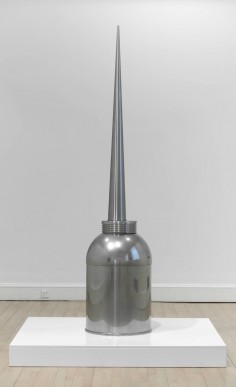ROBERT THERRIEN
No Title
source: nationalgalleries
Epic scale has been traditionally reserved for sculptures of political statesmen or sovereign leaders, where size is used to exert the powerful status of the subject. Therrien employs the same device for a mass-produced oil can. The object’s dimensions emphasise the elegant minimalism of its design, in which simple lines and shapes are reminiscent of the classical grandeur of heroic monuments. The highly polished surface captures the viewer’s own reflection in front of the sculpture. Dwarfed by the oversized structure, the artist seems to question the function of such a simple utilitarian object, and how we perceive ourselves in relation to it.
.
.
.
.
.
.
.
source: tateorguk
American sculptor and draughtsman. Based in Los Angeles, CA, he completed an MFA at the Univeristy of Southern California and began his career making reliefs that operated between painting and sculpture, using simplified forms that were generic and instantly recognisable. These works were placed on the wall and painted monochromatically, yet had enough structure to give them the feeling of an object. He also created freestanding works with the same simple, almost abstracted forms. In this early period, Therrien used a limited vocabulary, often working with the same shape in many different sizes and mediums. The motifs he used were linked by their simplicity and ability to evoke personal associations, marrying together a representational function and abstract form. His work took a change of direction in the late 1980s, when he began to make more explicit reference to real objects in his work. He also expanded his work into large installations that examine the viewer’s relationship to scale, much as Charles Ray was doing in his own sculpture. Therrien achieved such ends most impressively with his Under the Table (1994; see 2000 exh. cat.), where a kitchen table and chairs are enlarged into giant sculptures raised sufficiently high for one to be able to walk beneath them. Often alluding to modest household items from a domestic context, such as the stack of oversized plates featured in No Title (1999; Los Angeles, CA, Co. Mus. A.), Therrien uses them as elements in abstract sculptural psycho-dramas.
.
.
.
.
.
.
.
source: leopardinamiagola
掌握周遭環境的距離及尺寸大小,是動物必備的生存本能,生死攸關。我們雖然不再需要在叢林中博命相見,卻仍依賴這本能與世界聯繫,偶然打破常規的超比例演出,豐富了千篇一律的日常世界。
藝術與人類的歷史從來沒有分開過,從史前人類就已經在洞穴裡創作壁畫抒發情感,當然也在人類文明發展進程中扮演重要角色,為宗教傳遞推波助瀾,為君主統治歌功頌德,替政治活動宣導理念,而「巨大」這種慣用的表現手法,能夠輕易營造觀賞者的渺小感受。神話裡面的巨人巨獸所向披靡,更顯得平凡英雄之過人膽識,聖徒維護信仰之堅貞不移,而神祇君王肖像雕像,則藉由偉大比例顯現其永垂不朽,直覺性地感受到情緒為之牽動起伏。隨著啟蒙運動、科學及地理大發現、工業革命等等近代化腳步,藝術也與時並進,表現手法已經無遠弗屆,而藝術理論與流派更是百花齊放,巨大比例的藝術更加多元有趣,超現實主義畫家馬格利特為箇中翹楚,體積等同整個房間的玫瑰花或蘋果、巨型裸女與縮小的男人、飛翔在空中的巨石、夜裡靠著比薩斜塔的大湯匙等等,巨大的尺寸不再是偉大象徵,不再描繪傳說,比例異常的日常周遭元素,引發了人性本能的忐忑不安,而他筆下特有的靜謐氣氛,又讓畫作在視覺上一片祥和,尺寸比例的變幻在此經過多重轉折,成為讓人仔細玩味的雋永經典。
將日常生活元素比例為創作主軸的當代藝術家裡,Robert Therrien是一個絕對會被提到的名字。他在1947年出生於芝加哥,24歲移居洛杉磯,在八零年代就已經闖出名號,作品涵蓋繪畫、攝影,最廣為人知的是其雕塑創作,用生活中的常見物品為主題,桌子、椅子、鍋子、盤子這幾項特別深獲鍾愛,不斷重複出現於歷年作品中,2003年的無題(桌子與六張椅子),以長約八公尺、寬約三公尺、高約五公尺半的驚人尺度降臨,2006年的作品無題(曲線畢露的盤子),直徑就有137.2公分,高有238.8公分,頓時將參觀者全都拉回嬰兒時期,無可避免地立即與普遍的共同幼年回憶產生連結,在廚房裡仰望母親的忙碌背影,家具如同碉堡般保護著我們的成長過程,而那由低視角慢慢建立的世界,終於經由Robert Therrien的藝術再度重現。2008年的無題(一桌四椅)改為工作空間常見的折疊金屬家具、2010年的無題(油罐)、2011的無題(新巫師帽),則逐漸描繪出一個新的國度,也許是愛麗絲夢遊仙境、也許是傑克與豌豆、也許是葛列佛遊記,參觀者陷入某個好像熟悉的故事情節,頓時被引領到另一個時空,甚至是另一種運行的邏輯,從現實生活中被抽離,卻又身處在生活必備的物件之中,時間好像暫時停止了,新的觀察角度強迫我們用心觀看,展覽中時常還交錯著正常尺寸的相同物品,必須發揮生存本能再三確認,在新世界裡頭究竟得往巨人還是小人國的那方靠攏。
然而尺寸大小與比例,永遠是個需要相對應對象才能完整呈現的概念,Robert Therrien的作品在照片上要是沒有人員參與,很難理解其作品的意涵,也使得參觀者在作品裡扮演了不可或缺的角色,必須在桌椅間穿梭,才能顯現其已經等同小型建築體的份量,甚至能讓人攀爬到作品之上,如同克服萬難攻堅碉堡。而空間關係也是另一個重要的相對環節,展覽地點能讓Robert Therrien的作品呈現非常不同的結果,一桌六椅這件作品在2005年移駕紐約市麥迪遜大道,以公共藝術陳列在戶外開放空間,衍生出別於室內展覽的作品意涵,脫離美術館裡純白無暇的保護傘之後,在曼哈頓的摩天大樓間相對比例不再只有「巨大」,街頭繁忙的動態行人、車潮、路樹、甚至紐約惡名昭彰的鴿群,每個個體都與桌椅產生了不同的相對比例,宛如多個平行時空在此交疊,與作品不斷互動出多重的藝術結果。
Robert Therrien一手策劃了這場日常生活的巨型藝術公演,不僅止於縮放尺寸比例的表象視覺驚艷,更挑戰現實邏輯中的安全感與自我存在,讓一切的理所當然都應該被思考與質疑,試圖找回兒時曾擁有的奇幻視野,讓生活再也不那麼順理成章地只剩下乏味的日常。
.
.
.
.
.
.
.
source: gagosian
Working in both two and three dimensions, Robert Therrien transforms elements from the culture of everyday life into works of art that evoke classical archetypes. His deceptively simple oeuvre lends itself to psychological interpretation, given its evident fascination with the narratives of childhood, while remaining firmly objective due to its literal proximity to the real and its relationship to the minimal.
Robert Therrien was born in 1947 in Chicago. His work has been the subject of solo exhibitions at the Museum of Contemporary Art, Los Angeles (1984); Museum Nacional Centro de Arte Reina Sofía, Madrid (1991–92); Los Angeles County Museum of Art (2000; traveled to SITE Santa Fe, Contemporary Arts Museum, Houston, and Museo de Arte Contemporáneo, Monterrey, Mexico, through 2001); Albright-Knox Art Gallery, Buffalo, New York (2006, 2007, and 2013), Museum of Contemporary Art San Diego (2007), Kunstmuseum Basel (2008); De Pont Museum, Tilburg, Netherlands (2011); and again at the Los Angeles County Museum of Art in 2011–12. Since 2009, a major group of his works has been part of ARTIST ROOMS, a collection of international contemporary art established through The d’Offay Donation with the assistance of the National Heritage Memorial Fund, The Art Fund and the Scottish and British Governments—most recently on view at the Paxton House, Berwick upon Tweed, England in 2013.
Therrien lives and works in Los Angeles.


